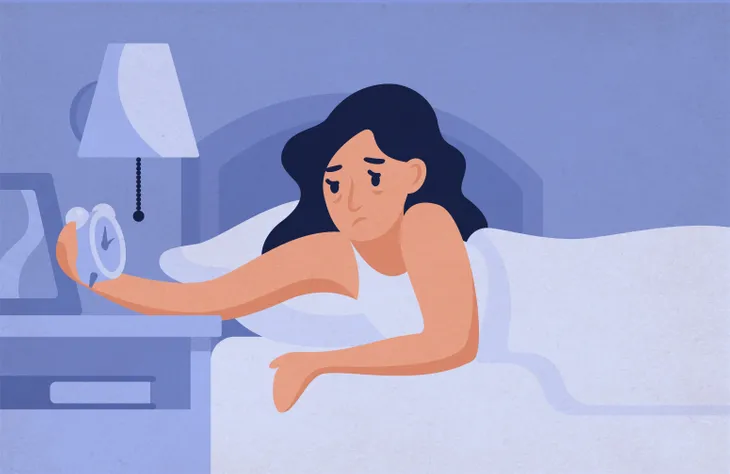- Fibromyalgia is a chronic condition that causes widespread pain and stiff muscles, along with a slew of other symptoms.
- Symptoms differ greatly between individuals, but when they temporarily increase in number and intensity, this is referred to as a flare or flare up.
- There are several common triggers for fibromyalgia flares, including weather/temperature changes, poor sleep and diet, as well as travel and stress.
- Treatment in the form of medication is limited. A more effective option is to prevent and manage flares as best as possible.
While it’s not a medical condition we often hear about, it’s certainly not uncommon. Experts estimate around 4 million adults in the U.S. suffer from fibromyalgia. Most are women as they are twice as likely to have it, says Medical News Today. Children can also have it, but it’s more common among adults.
The most common identifier of this condition is pain which can be so severe that it affects daily life, including everyday mundane activities. The severity of symptoms can vary between people, along with what triggers them to occur. Here’s a look into the most common fibromyalgia flares, as well as how to manage and prevent them…
Symptoms of Fibromyalgia
The main symptom associated with fibromyalgia is widespread pain, but there are several others. The degree in which people experience these symptoms varies between person and can fluctuate, including how often. Medical News Today explains that when symptoms temporarily increase in number and intensity, it’s known as a flare or flare-up. These can last anywhere from days to weeks.
Other common symptoms are stiffness and tenderness in the muscles, tendons, and joints. Some people may have dizziness, clumsiness, or experience a change in body temperature, from too hot too cold. There can be periods where they experience pain, restless leg syndrome, or even numbness and tingling in the hands and feet, says Medical News Today.
The same source lists the following as other potential symptoms of fibromyalgia:
- Pain throughout the body – particularly in the back or neck
- Extreme sensitivity to touch, light, smoke, and certain foods
- Stiffness when in the same position for too long
- Muscle spasms
- Poor sleep
- Extreme fatigue
- Slow or confused speech
- Poor memory or concentration – also known as “fibro fog”
- Frequent headaches and migraines
- Irritable bowel syndrome
Triggers for Fibromyalgia Flares
Physical or Psychological Stress
Stress is a major trigger for fibromyalgia and oftentimes can make symptoms worse. According to Medical News Today, many people with this condition experience feelings of stress, depression, anxiety, and frustration. “Any type of stress – not just psychological but also physical, immune or anything that disrupts the body’s normal routine – can trigger a flare,” says Daniel Clauw, MD, professor of anesthesiology, rheumatology and psychiatry at the University of Michigan in Ann Arbor to the Arthritis Foundation.
“Anything from a motor vehicle accident to surgery or another type of stressful life event can cause a worsening of symptoms.” To avoid this, try not to overdo it during exercise or any form of activity. Even if you’re feeling well, it’s best to pace yourself.
Temperature and Weather Changes
Another very common trigger for most people with fibromyalgia is temperature and weather changes. “Whenever the barometric pressure changes and a new front passes through, many people with fibromyalgia experience an increase in their symptoms — particularly in their pain level,” writes Health Central. While these triggers are unfortunately outside of our control, the good news is that these flares only last a day or two.
Along with the weather, people with fibromyalgia are often sensitive to both heat and cold, or both. Exposure to either one of these for any period of time can sometimes trigger a flare, says Health Central.
Traveling
While some people love the excitement of traveling, it can also be incredibly stressful for even the healthiest of individuals. For people with fibromyalgia, traveling is a common trigger, even after what was seemingly the best trip ever. Health Central suspects the reason for this is because it often involves other triggers like temperature or weather changes, as well as stress and sleep disruption.
The obvious way to avoid this trigger is by not traveling, but that’s not practical. People with fibromyalgia should be able to live their lives as they want which sometimes includes a getaway or trip. To avoid a flare up afterwards, try to plan for plenty of rest both during the trip and afterwards. You can do this by adding an extra day into the trip for rest and then another when coming home. Even if this doens’t prevent a flare up, it might help minimize its severity.
Change in Treatment
When a person changes their treatment, it’s often a sign they are trying to improve their symptoms, not make them worse. Unfortunately with fibromyalgia, this is the outcome that often occurs. Sometimes a change in treatment can instigate a fibromyalgia flare.
However, as Health Central points out, it can be hard to tell if the flare is a result of the change in treatment, or just a coincidence. “It may take a period of trial and error, working with your doctor to figure out whether the treatment change is to blame or if some other factor triggered the flare,” writes the source.
Hormonal Changes
We blame a lot of problems on our hormones – and for good reason! They can wreak havoc on our health, from affecting weight, sleep, and even our mood. Another thing to add to the list is that they can induce a fibromyalgia flare. According to Health Central, many women report experiencing a fibromyalgia flare up during their menstrual cycle and menopause.
This is another trigger that is outside anyones control. People with this known trigger should talk to their doctor about any possible treatment options for them, such as hormone replacement therapy (HRT). It’s not for everyone and is very much based on the individual.
Diet
Diet, particularly changes to diet, can induce a fibromyalgia flare up. Medical News Today notes there is no special diet for this condition, but certain foods can make symptoms worse. To combat this, the source suggests trying an elimination diet. Exclude certain food groups for a week at a time to see if symptoms improve. You’ll hopefully be able to figure out what foods are triggering and reduce any flare ups.
While there is no specific diet, Medical News Today refers to some studies which found that diets such as Mediterranean, vegetarian, low gluten, and a low FODMAP may help manage fibromyalgia symptoms. If anything, good nutrition can improve other aspects of health like boosting energy and maintaining a healthy weight which will also have a positive impact on fibromyalgia.
Poor Sleep
Sleep is so important for our overall health. We’ve all endured the effects of a poor nights sleep and how it causes us to be tired, groggy, and just not in a good mood the next day. For people with fibromyalgia, a lack of sleep is a recipe for all of that and a flare up. “Flares can also be caused by behavioral triggers such as not sleeping well, suddenly stopping exercise, or overdoing it on activity,” says Dr. Clauw to the Arthritis Foundation.
What makes it even worse is that among the symptoms of fibromyalgia is trouble falling asleep or frequent wake ups in the night. WebMD points out that some studies have found that people with fibromyalgia struggle never feel rested because they aren’t able to get into a deep sleep. “This means your body doesn’t get the chance to repair itself, which can lead to a cycle: poor sleep may make pain seem worse, and pain prevents good sleep,” writes the source.
How to Manage a Fibromyalgia Flare Up
Prioritize Self-Care
Not surprisingly, the first suggestion when it comes to both managing and preventing a fibromyalgia flare up is practice self-care. This can reduce stress and encourage relaxation. Some of the best ways to do this are through meditation or deep breathing. During times of a flare up it’s important to prioritize your own needs. Don’t be afraid to cancel or reschedule plans. Give yourself a break, or just say no. You should also get lots of sleep because a lack of it plays a big role in fibromyalgia symptoms.
Medical News Today explains that it’s important to not stop exercising, even during flares (if possible). “People with fibromyalgia who quit work or stop exercising do not do as well as those that stay active,” writes the source. When doing so, listen to your body. Know its limits and try not to over do it. There’s no shame in going at a slow and steady pace. “Gentle stretching, a leisurely walk, or some easy yoga moves can keep you moving enough to help reduce the pain,” writes Everyday Health.
Medication and Treatment Options
Unfortunately there is no magic pill to get rid of a fibromyalgia flare. According to Dr. Clauw who talked to the Arthritis Foundation, it’s a lot easier to prevent a flare up than it is to treat one. “There’s no rescue medication for fibromyalgia. The medications approved for fibromyalgia take weeks to start working, and pain medications […] don’t work well for a lot of people.”
Because of this, flares can be extremely hard to manage which is why a lot of people with fibromyalgia are unable to work or even be all that functional at home. Most treatment plans will be a combination of medication and lifestyle changes, says Medical News Today.
Alternative Treatments
In the absence of medication, one way a person can try to manage the pain associated with fibromyalgia is through mind body practices. The Arthritis Foundation suggests trying meditation, deep breathing, and forms of exercise that include stretching and relaxation, such as yoga. These will not only help relieve pain, but also act as a mood lifter.
Other easy at-home practices to try are drinking more water to keep the body well hydrated and aid in riding the body of toxins. “Being properly hydrated also helps alleviate fatigue and aids your body in properly processing medications,” writes Everyday Health.
In addition to practices like meditation and relaxing forms of exercise, there are alternative treatments. Everyday Health suggests trying acupuncture, chiropractic care, massage, biofeedback, or other similar therapies. These are great options for people who aren’t finding success through more conventional means. Or can be in addition to those. Be sure to look for providers who are familiar with the special needs of people with fibromyalgia.
How to Prevent a Fibromyalgia Flare
Sometimes a person cannot control whether or not they have a fibromyalgia flare up because it’s influenced by outside factors (i.e., weather or holidays), but one good way of reducing the risk is to invest in self-care. The Cleveland Clinic suggests doing things that reduce stress (i.e. exercise, meditation), eat healthy foods, get lots of sleep, maintain a healthy weight, stay active, and try to manage arthritis, depression or any other accompanying conditions.
Try not to overdo it, even when feeling well. This is a common mistake people with fibromyalgia make. Pacing yourself is a key component of prevention. You should also keep a log of triggers to help anticipate when a flare up might occur and hopefully avoid it altogether. Medical News Today suggests logging activities, meals, sleep times, and symptoms to help identify potential triggers.















